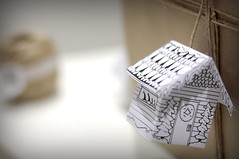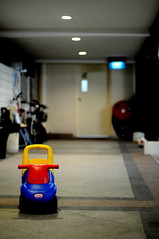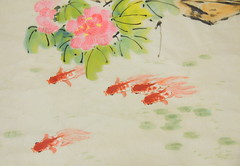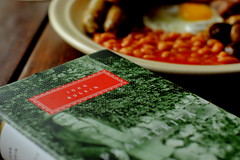They Built Their Houses with Paper and Gingerbread
If we were yet another spore in the mushrooming indie bandwagon (cheesy mixed metaphors due completely to all that Christmas cheese), we would call ourselves "The Paper Houses". Our eponymous debut album would contain the hit singles "People In Paper Houses Shouldn't Light Fires" and "Oh! My Soggy Foundations!".
Fascination with Anna Torborg's paper house templates over at Twelve22 led several happy hours singing carols while trying to deflect attention from poorly wrapped presents with tiny personalised houses.
I liked the tension in the window of the music cafe best with its black cat eyeing a platter of cupcakes, a picture of feline self-control.
The minature home-making continued with gingerbread houses that perched on the rims of mugs of hot tea (until the heat got to the icing) (cheers notmartha).
When the neighbours weren't busy being traumatised by the singing and the smell of burnt gingerbread, they might have caught snippets of podcasts from St. Matthew's Unichurch, Perth.
Thanks to Hayao Miyazaki's Howl's Moving Castle, Rory Shiner's exposition on Romans 6 brought to mind the image of Jesus as a flying home (interestingly The Flying House was a Christian anime series).
It is commonly said in some circles of living the Christian life that, well, the ceremonial law has been abolished but the law is still useful for holiness now that we've understood the gospel and that actually, grace and salvation are conditional on our morals and good behaviour.
But Paul says that the reason that Christians will not and cannot continue in sin because in Christ, we died to sin.
When a Christian puts his trust in Christ to save him from God's judgement on his sins, he does not sign a contract to perform services to God in exchange for salvation. But neither does he merely agree to abide by the terms of membership of the Christian club to follow Christ or be under the rule of Christ, nor is it only that the Spirit comes to live in him to enable him to live as a Christian. Far more than that, the Christian is in Christ - he is crucified with Christ, buried with Christ and raised with Christ (Romans 6:3-5); he is united with Christ.
Christ is a place and the Christian is in him. Christ is like the plane that goes from Singapore to Helsinki (SIN-HEL, haha) and if we are in that plane, we too go from Singapore to Helsinki. What happened to Jesus also happens to the Christian. The Christian participates in the full benefits of what Jesus has to offer and all his blessings, regardless of whether he is quivering in his seat or if he has taken off his shoes and started snoring even before take off.
Christians coming into Christ have, in fact and not as a metaphor, had their old selves killed and buried. Our old selves are not things that have to be beaten into submission so that they will one day; give up the ghost; they are already dead and buried.
If our old sinful selves are dusty history, then because this is true, we must live out the reality that we are dead to sin (Romans 6:11). The imperative is not to pretend for the purposes of the exercise that we are free, but, because our minds are so used to being enslaved to sin, to keep reminding ourselves that we are now, in fact, free from having to obey our sinful thoughts and desires. To return to sin would be as absurd as an emancipated slave running back to be chained to a galley with little food and water and to be ill-treated and then die a painful torturous death because "I can't help it, I just need to do it. My family background and genes compel me to do it." or "I cannot be happy and satisfied in life until I return to slavery" (Romans 6:12-23).
Organically, something has changed in the Christian. The Christian life is then about reckoning to ourselves what God has reckoned to us: freedom from the slavery of sin and freedom to fulfil our full potential as human beings - as slaves of God (Romans 6:15-23).
Monty, the cliché from 2009, says "Know the truth and the truth will set you free".
Labels: *Romans, All Given For Food: Bake and Cake, Art/Architecture/Design, Christmas





































































